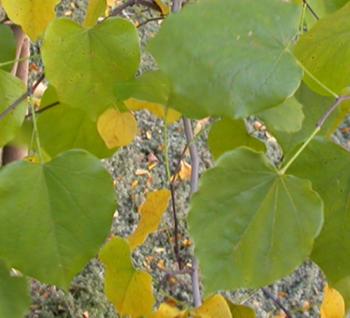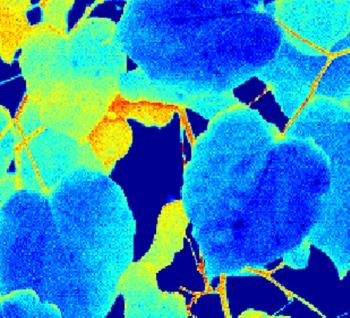[This blog reflects the help of many friends and colleagues. The story of how it developed shows how science research often works. The idea for this blog came from Professor Peter Blanken of the University of Colorado, who took advantage of a beautiful autumn day to take his biometeorology class outside so that the students could measure and compare the temperatures of yellow leaves and green leaves. I found out about Professor Blanken's field trip from Joe Alfieri. Joe, a graduate student from Purdue University, was visiting me for a few weeks. Joe and I decided to have our own field trip, using the infrared thermometers we used to measure puddle temperatures. When Joe and I told a colleague here at NCAR, Jielun Sun, what we were doing, she suggested we borrow an infrared digital imager from Janice Coen, an NCAR scientist who uses it to look at forest fires. Sean Burns of NCAR and Jielun showed us how to use the camera. Joe processed the images and produced the figures. They are all gratefully acknowledged.]
What happens to leaves when they change color? Leaves are green because of chlorophyll, which is involved in photosynthesis. In photosynthesis, sunlight, carbon dioxide, and water are turned into glucose, which is used by the plant. In the autumn, as the days get shorter, photosynthesis stops and the chlorophyll disappears, leaving behind other materials that give the leaves their color.
As noted in a previous blog, shutting down of photosynthesis in the Northern Hemisphere autumn actually shows up as an increase in the carbon dioxide in our atmosphere (Remember – there is more land – and trees – in the Northern Hemisphere). GLOBE’s Seasons and Biomes Project and Carbon Cycle Project (found under the “Projects” drop-down menu at www.globe.gov) are both interested in the seasons and how they affect the earth system.
Green leaves also give off water vapor in a process called transpiration, which is a fancy name for evaporation from plants (mostly from leaves). When leaves open their “pores” (stomata) to allow carbon dioxide to enter for photosynthesis, water evaporates. Yellow leaves don’t transpire. Does this mean that the temperatures of green leaves and yellow leaves are different?
Blanken thought that the color of the leaves would affect their temperature. Joe Alfieri and I thought so too. But how much? We decided to go outside and measure leaf temperatures ourselves.
We still had the infrared temperature sensor from when we measured puddles. We used the sensors to measure leaf temperature. We found trees near the office with both yellow and green leaves, and measured the temperatures of individual leaves. We measured leaves in pairs – one yellow leaf and one green leaf for each tree. We measured leaves on “weeds” as well.
The GLOBE infrared thermometer wasn’t working, so we used another one. (More information on the GLOBE infrared temperature (“surface temperature“) protocol can be found at www.globe.gov in the “Teachers Guide”, in the drop-down menu for “Teachers”). We had compared it to the GLOBE instrument earlier and found the temperatures were off – but the temperature differences were the same for both instruments. So I will discuss temperature differences rather than actual temperatures. From the weather station at our building, the temperatures on all three days were between 20 and 25 degrees Celsius. We took data for red and brown leaves as well, but there were so few I am including only the yellow and green ones. Measurements were made during the last two weeks of September.
The first day, it was sunny. We knew that leaves in full sunlight would be warmer than leaves in shadow, so we tried to compare leaves that were either both in shade, or both in full sunlight. On this day, the yellow leaves were on average 1.6 Celsius degrees warmer than the green ones.
The second day was mostly cloudy with low clouds blocking the sun, making it easier to get leaves exposed to a similar amount of sunlight. On this day, the yellows were on average 1.2 Celsius degrees warmer than the green ones.
The third day was cool and windy. We found we had to hold the end of a leaf to measure it. Otherwise, the leaf would blow around and we couldn’t get a good reading. The yellow leaves were on average 1.3 Celsius degrees warmer than the green ones.
The measurements varied a lot for all three days. Differences varied from -0.2 Celsius degrees (green leaf warmer) to 7 Celsius degrees. Part of the reason for this variation is that some of the leaves were more shaded than others. Also, leaves directly facing the sun tend to be warmer. (If a leaf is oriented so its edge faces the sun, it will be cooler. I had a friend who really really liked to sunbathe. He found out that he could stay outside in cooler temperatures by tilting himself so that his body was directly facing the sun). Wind might make the temperature differences smaller. In spite of these factors, the yellow leaves were between 1 and 2 Celsius degrees warmer than the green ones.
The figures below show the same leaves photographed with an ordinary digital camera and an infrared camera (more properly, infrared imager) that scientists use to measure the temperatures of fires, trees, and surfaces. In the figures, the blue colors mean cooler temperatures than the yellow ones, which are cooler than the reds. Like our measurements, the infrared camera is “seeingâ€? yellow leaves as warmer as well. Notice that the stems are warmer, too, especially the thicker ones. We didn’t calibrate the camera exactly, but estimate the temperature difference between the yellow and green leaves to be about the same as we observed.

Figure 1. Poplar leaves photographed using a digital camera.

Figure 2. Same leaves, photographed using the infrared imager.
Why are the yellow leaves warmer? Remember that leaves lose water during transpiration. This means that the water turns from a liquid to a gas – it evaporates. Just as perspiration evaporating from our bodies keeps us cool, the water escaping from the leaf cools it off a little bit. It takes energy for molecules to escape a liquid to become part of a gas – and this energy loss is what cools the leaf. The same thing happens to you getting out of a swimming pool or shower – you are cooled off as the water on your skin evaporates.
POSTSCRIPT. If the leaves are cooler because of transpiration from open stomata, Sun hypothesized that yellow and green leaves should have the same temperature in the early morning, before the stomata open up. To test this, Blanken took leaf-temperature measurements at 7 a.m. Local Standard Time, 50 minutes after sunrise (6:10 a.m. Local Standard Time), on 15 October 2007, when the temperature was 4.5 Celsius degrees, relative humidity ~90+%. He found that the yellow leaves and the green leaves had about the same temperatures. This could be because the stomata are closed. However, the low temperature and high relative humidity that morning would reduce the evaporation rate, so even if the stomata were open, the leaf-temperature differences would still be small. In either case, the lack of temperature difference is related to little or no evaporation.
